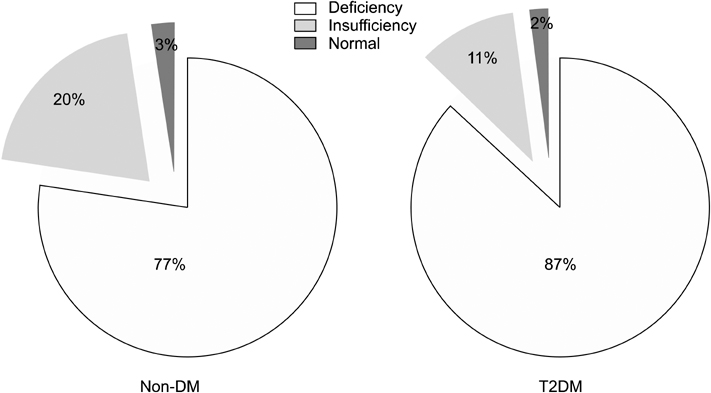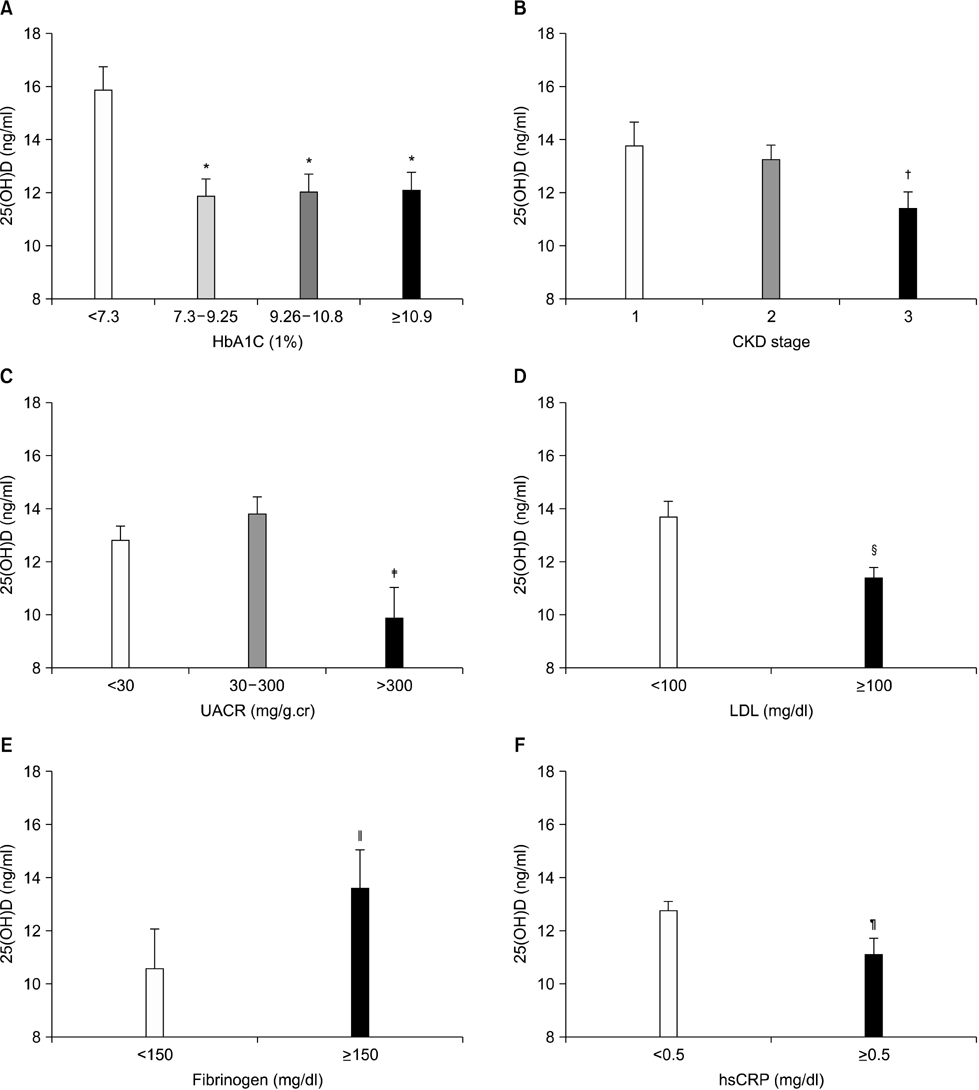Chonnam Med J.
2012 Aug;48(2):108-115. 10.4068/cmj.2012.48.2.108.
Serum Vitamin D Status and Its Relationship to Metabolic Parameters in Patients with Type 2 Diabetes Mellitus
- Affiliations
-
- 1Department of Internal Medicine, Jeju National University School of Medicine, Jeju, Korea. drdhkso@hanmail.net
- 2Department of Family Medicine, Jeju National University School of Medicine, Jeju, Korea.
- 3Department of Internal Medicine, Konyang University School of Medicine, Daejeon, Korea.
- KMID: 2172212
- DOI: http://doi.org/10.4068/cmj.2012.48.2.108
Abstract
- The potential relationship between vitamin D (VitD) status and metabolic control in patients with type 2 diabetes mellitus (T2DM) warrants further study. We aimed to evaluate the relationship between the serum 25-hydroxyvitamin D [25(OH)D] level and various parameters in patients with T2DM. We analyzed retrospectively data from 276 Korean patients with T2DM whose serum 25(OH)D level was measured in our hospital. Nondiabetic healthy subjects who visited the hospital for health screening were selected as the control group (Non-DM, n=160). Compared with control subjects, patients with T2DM had a lower serum 25(OH)D level (15.4+/-0.5 vs. 12.9+/-0.4 ng/ml, p<0.01). Eleven percent of T2DM patients were VitD "insufficient" (20-29 ng/ml) and 87% of the patients were VitD "deficient" (<20 ng/ml). The serum 25(OH)D level was significantly related to serum fibrinogen, triglyceride (TG), low-density lipoprotein cholesterol (LDL-C), ferritin, the urine albumin creatinine ratio, and hemoglobin A1C (HbA1C). In a multivariate logistic regression analysis, high levels of HbA1C, TG, and LDL-C were independently associated with VitD deficiency in T2DM patients. The results of the present study show that the majority of Koreans with T2DM are VitD deficient, and the serum 25(OH)D level in patients with T2DM is related to lipid and glucose parameters. Further studies are required of the relationship of VitD with fibrinogen and other related parameters.
MeSH Terms
Figure
Reference
-
1. Holick MF. Vitamin D deficiency. N Engl J Med. 2007. 357:266–281.
Article2. Davies JH, Shaw NJ. Preventable but no strategy: vitamin D deficiency in the UK. Arch Dis Child. 2011. 96:614–615.
Article3. Lee JI, Oh SJ, Ha WC, Kwon HS, Sohn TS, Son HS, et al. Serum 25-hydroxyvitamin D concentration and arterial stiffness among type 2 diabetes. Diabetes Res Clin Pract. 2012. 95:42–47.
Article4. Fraser A, Williams D, Lawlor DA. Associations of serum 25-hydroxyvitamin D, parathyroid hormone and calcium with cardiovascular risk factors: analysis of 3 NHANES cycles (2001-2006). PLoS One. 2010. 5:e13882.
Article5. Hyppönen E, Power C. Hypovitaminosis D in British adults at age 45 y: nationwide cohort study of dietary and lifestyle predictors. Am J Clin Nutr. 2007. 85:860–868.
Article6. Ahmed SF, Franey C, McDevitt H, Somerville L, Butler S, Galloway P, et al. Recent trends and clinical features of childhood vitamin D deficiency presenting to a children's hospital in Glasgow. Arch Dis Child. 2011. 96:694–696.
Article7. Bikle D. Nonclassic actions of vitamin D. J Clin Endocrinol Metab. 2009. 94:26–34.
Article8. Pittas AG, Chung M, Trikalinos T, Mitri J, Brendel M, Patel K, et al. Systematic review: Vitamin D and cardiometabolic outcomes. Ann Intern Med. 2010. 152:307–314.
Article9. Pittas AG, Lau J, Hu FB, Dawson-Hughes B. The role of vitamin D and calcium in type 2 diabetes. A systematic review and meta-analysis. J Clin Endocrinol Metab. 2007. 92:2017–2029.
Article10. Bland R, Markovic D, Hills CE, Hughes SV, Chan SL, Squires PE, et al. Expression of 25-hydroxyvitamin D3-1alpha-hydroxylase in pancreatic islets. J Steroid Biochem Mol Biol. 2004. 89-90:121–125.11. Rajakumar K, de las Heras J, Chen TC, Lee S, Holick MF, Arslanian SA. Vitamin D status, adiposity, and lipids in black American and Caucasian children. J Clin Endocrinol Metab. 2011. 96:1560–1567.
Article12. Wang TJ, Pencina MJ, Booth SL, Jacques PF, Ingelsson E, Lanier K, et al. Vitamin D deficiency and risk of cardiovascular disease. Circulation. 2008. 117:503–511.
Article13. Hu FB, Meigs JB, Li TY, Rifai N, Manson JE. Inflammatory markers and risk of developing type 2 diabetes in women. Diabetes. 2004. 53:693–700.
Article14. Pittas AG, Dawson-Hughes B. Vitamin D and diabetes. J Steroid Biochem Mol Biol. 2010. 121:425–429.
Article15. Joergensen C, Gall MA, Schmedes A, Tarnow L, Parving HH, Rossing P. Vitamin D levels and mortality in type 2 diabetes. Diabetes Care. 2010. 33:2238–2243.
Article16. Alemzadeh R, Kichler J, Babar G, Calhoun M. Hypovitaminosis D in obese children and adolescents: relationship with adiposity, insulin sensitivity, ethnicity, and season. Metabolism. 2008. 57:183–191.
Article17. Chonchol M, Scragg R. 25-Hydroxyvitamin D, insulin resistance, and kidney function in the Third National Health and Nutrition Examination Survey. Kidney Int. 2007. 71:134–139.
Article18. Kositsawat J, Freeman VL, Gerber BS, Geraci S. Association of A1C levels with vitamin D status in U.S. adults: data from the National Health and Nutrition Examination Survey. Diabetes Care. 2010. 33:1236–1238.19. Hyppönen E, Boucher BJ, Berry DJ, Power C. 25-hydroxyvitamin D, IGF-1, and metabolic syndrome at 45 years of age: a cross-sectional study in the 1958 British Birth Cohort. Diabetes. 2008. 57:298–305.20. Hyppönen E, Berry D, Cortina-Borja M, Power C. 25-Hydroxyvitamin D and pre-clinical alterations in inflammatory and hemostatic markers: a cross sectional analysis in the 1958 British Birth Cohort. PLoS One. 2010. 5:e10801.
Article21. Scragg R, Sowers M, Bell C. Third National Health and Nutrition Examination Survey. Serum 25-hydroxyvitamin D, diabetes, and ethnicity in the Third National Health and Nutrition Examination Survey. Diabetes Care. 2004. 27:2813–2818.
Article22. McGill AT, Stewart JM, Lithander FE, Strik CM, Poppitt SD. Relationships of low serum vitamin D3 with anthropometry and markers of the metabolic syndrome and diabetes in overweight and obesity. Nutr J. 2008. 7:4.23. Choi HS, Oh HJ, Choi H, Choi WH, Kim JG, Kim KM, et al. Vitamin D insufficiency in Korea--a greater threat to younger generation: the Korea National Health and Nutrition Examination Survey (KNHANES) 2008. J Clin Endocrinol Metab. 2011. 96:643–651.
Article24. Suzuki A, Kotake M, Ono Y, Kato T, Oda N, Hayakawa N, et al. Hypovitaminosis D in type 2 diabetes mellitus: Association with microvascular complications and type of treatment. Endocr J. 2006. 53:503–510.
Article25. Kos E, Liszek MJ, Emanuele MA, Durazo-Arvizu R, Camacho P. The effect of metformin therapy on Vitamin D and B12 levels in patients with diabetes mellitus type 2. Endocr Pract. 2012. 18:179–184.
Article26. Payne JF, Ray R, Watson DG, Delille C, Rimler E, Cleveland J, et al. Vitamin D insufficiency in diabetic retinopathy. Endocr Pract. 2012. 18:185–193.
Article27. Aihara K, Azuma H, Akaike M, Ikeda Y, Yamashita M, Sudo T, et al. Disruption of nuclear vitamin D receptor gene causes enhanced thrombogenicity in mice. J Biol Chem. 2004. 279:35798–35802.
Article



